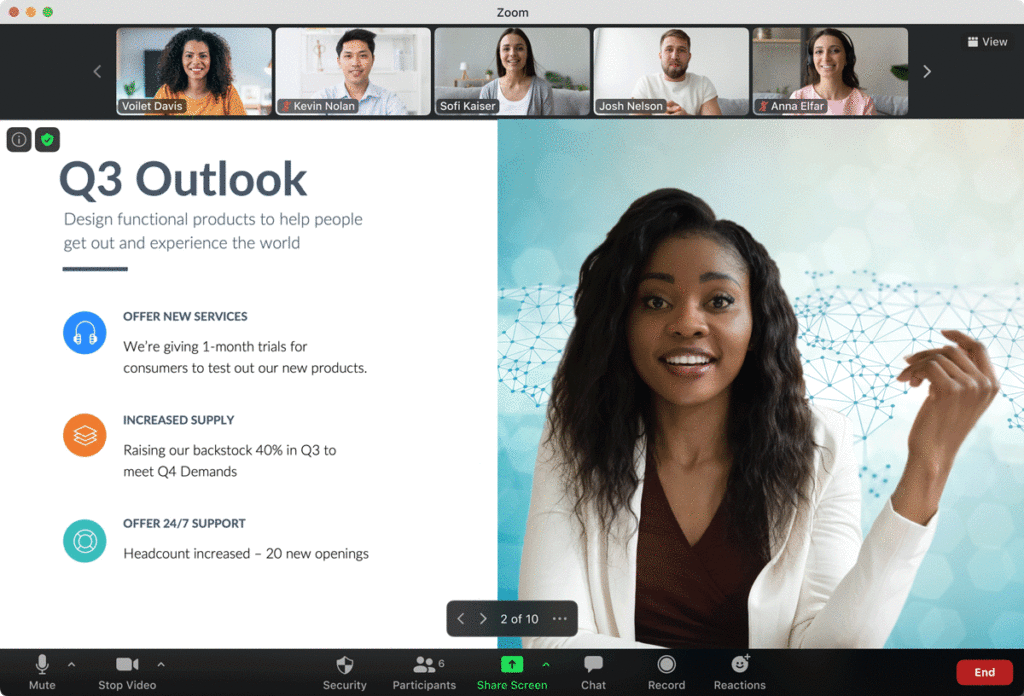Zoom
Zoom is a videoconferencing application that supports meetings with 1-300 people (or up to 500 or 1000 people as needed, upon request1).
As a campus platform, it integrates with both Brightspace (to manage providing access to students in a course) and YuJa (to optionally migrate recordings for sharing).
Types of uses
- synchronous online classes
- meetings
- presentations
- 1:1 consultations
- interviews
- small-group discussions in breakout rooms
- producing recorded video for use in courses
- in-meeting tools: whiteboard, annotation, polls
What it looks like

Considerations before using this tool
Safety
How will you deal with any disruptive behaviour that may occur in an online meeting? How will you respond if a student, faculty or staff member has a negative experience or is being targeted during the meeting? How can you mitigate any online harassment that might take place?
Comfort and Ease of Use
What protocol will you follow to promote respect in your online class or meeting? What do you want students, faculty or staff to do if they feel uncomfortable in this online space?
Security
How will you comply with relevant data retention rules?
Pedagogy
How can this tool efficiently serve the purposes of your course? How will you use its different features to improve online teaching and learning? How will you promote academic integrity in your online class?
Support available
- UService (IT)
- Taylor Institute:
- UCalgary elearn resources: Getting Started with Zoom
- workshops: workshop calendar, training videos
- consultations: one-on-one consultation, learning technology coaches
- Zoom
Useful information and tips
- IT can provide “Large Meeting” or “Webinar” licenses to instructors on request
- UCalgary Online meeting tools – update (April, 2020)
- 8 Tips How to Use Zoom Like a Pro
- Tips & Tricks: Teachers Educating on Zoom
About this tool
Name: Zoom
Vendor: Zoom, Inc.
Website: https://ucalgary.zoom.us
Cost: Free (campus license provided)
Status: core platform. Integrated with campus logins, Brightspace, and YuJa.
Approved for:
Level 1 Data: Public
Public is defined as:
- Information deemed to be public by legislation and/or under University policy
- Information in the public domain
Examples include:
- names of employees and
- business contact information
- job profile
- salary range
- discretional benefits
- relevant education
- names of registered students and
- dates of registration
- program of registration
- degree awarded
- convocation date
- annual reports
- public announcements
- telephone directory
- published research data
Level 2 Data: Internal Use
Internal Use is defined as:
- Information not approved for general circulation outside the University
- Information the disclosure or loss of which would inconvenience the University although it would unlikely result in financial loss or reputational damage
Examples of this include:
- internal memos sent to all members of a department
- minutes of department meetings that are circulated to all members of a department
- unpublished research data
- anonymized or de-identified human subject data
- library transactions and journals
Level 3 Data: Confidential
Confidential is defined as:
- Information that is available only to authorized persons
- Information the disclosure or loss of which could seriously impede the University’s operations
- Information the disclosure or loss of which may:
- adversely affect the University’s operation; or
- cause reputational damage; and
- obligate the University to report to the government or other regulating body and/or provide notice to affected individuals.
Examples include:
- faculty/staff employment applications, personnel files, date of birth, health information and personal contact information
- admission applications
- student enrollment status
- donor or prospective donor name and contact information
- information commonly used to establish identity such as a driver’s license or passport
- contracts
- intellectual property
- authentication verifiers including:
- passwords
- shared secrets
- cryptographic private keys
Level 4 Data: Restricted
Restricted is defined as:
- confidential; and
- subject to specific privacy and security safeguards under law, policy or contractual agreement.
- Information the loss or disclosure of which could cause severe harm to individuals or the University
- Information the loss or disclosure of which may obligate the University to report to the government or other regulating body and/or provide notice to affected individuals.
Examples include:
- payment card information including:
- PAN
- cardholder name
- VV2/CVC2/CID
- health information when it can be linked to an identifiable individual including:
- information about health status
- diagnostic,treatment or care information
- payment for health care
- identifiable human subject research data
- information that is subject to special government requirements in the interests of national security
For more information, please refer to the University of Calgary’s Information Security Classification Standard.
Software license: Commercial, proprietary
Hosting: Servers hosted by vendor

